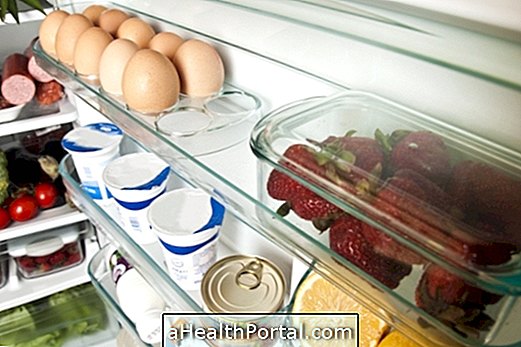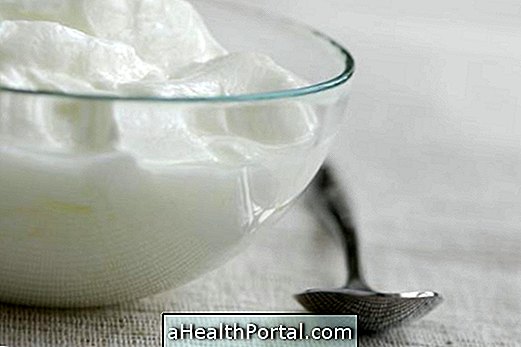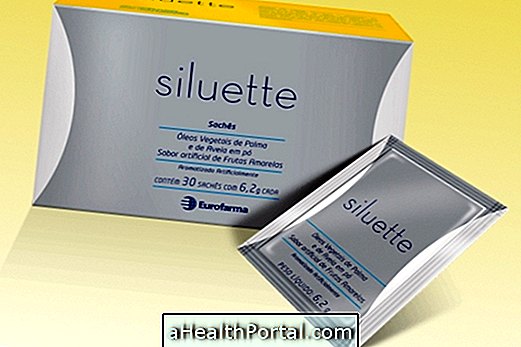To keep food in the refrigerator longer without risk of spoiling, you must cook and store food properly and be careful with cleaning the kitchen, countertops and hands.
In addition, the temperature of the refrigerator should always be kept below 5ºC, because the lower the temperature, the slower the growth of microorganisms that spoil food and cause intestinal infections such as gastroenteritis that generates symptoms such as acute abdominal pain and diarrhea.
Learn how to keep your refrigerator and freezer always clean and organized.

How to organize food in the refrigerator
Each food in the refrigerator should be stored in closed containers or bags so that it does not come into contact with other products that may be contaminated. Also, do not overfill the refrigerator, so cold air circulates more easily and conserve food for longer.
To reduce the risk of food contamination, the refrigerator should be organized as follows:
- Top: yogurts, cheeses, mayonnaise, pates, ham and eggs;
- Intermediate part: in the upper shelf, cooked foods are placed;
- Bottom shelf : meats and fish raw or in the process of thawing;
- Drawer: fresh fruits and vegetables;
- Door: milks, olives and other preserves, condiments, butter, juices, jellies, water and other beverages.
A tip for keeping vegetables and seasonings chopped longer, you should wash and dry each vegetable well before putting them in the refrigerator, covering the storage container with paper towel to absorb excess water that forms in the cold environment .
Foods that do not need to stay in the refrigerator
The list below indicates foods that do not need to be stored inside the refrigerator:
- Onion because it spoils faster than in the pantry;
- Garlic because it can run out of flavor and musty faster;
- Tomato because it can lose the flavor;
- White potatoes or sweet potatoes because they can get drier and take longer to cook;
- Pickled pepper because it already has ingredients that keep it from spoiling;
- All kinds of bread because it makes it dry faster;
- Honey or molasses because they will crystallize;
- Fruits like banana, apple, pear, mandarin or orange because they lose their antioxidants, the ideal is to buy in smaller amount;
- Fruits such as papaya, watermelon, melon or avocado after being opened can be left in the refrigerator wrapped with plastic film;
- Pumpkin because it loses liquid and flavor and therefore needs to be kept in a dark but well ventilated place;
- Peanut butter and nutella p orque become hard and dry, so they should always be inside the dispenser or on a clean bench, with a tightly closed package;
- Carrot because it can get dry and tasteless, prefer an airy place, but sheltered from the light;
- Chocolates even though they are open because it is hard and tends to have a different smell and taste, never leave it near the onion;
- Breakfast cereals because they can get less crunchy;
- Condiments and spices such as oregano, parsley, chili powder, paprika should not be left in the refrigerator because they can get moist and lose their flavor;
- Industrialized sauces like ketchup and mustard do not need to stay in the refrigerator because it contains preservatives that keep them for a long time even at room temperature;
- Biscuits even in open embedding because the moisture can take the crispness and get flavored different from the original.
Eggs can be stored in the refrigerator because they at room temperature only last for 10 days, but can last longer when placed in the refrigerator because cold temperature helps to preserve them.
When the fruit is very ripe, it is advisable to place it in the refrigerator because it is ripe for ripening and makes it last longer, but for better preservation of fruits and vegetables it is advisable to buy only enough for the week, because this does not risk spoiling easily in the pantry, and there is no need to store it in the refrigerator.
Learn how to make herbal salt, which also does not need to be in the refrigerator in the following video:

Validity of food in the refrigerator
Even if a food looks good in the refrigerator, it may be contaminated with fungi and bacteria, and you should always respect the shelf life of each. The following table shows the shelf life of the food when stored properly in the refrigerator.
| Food | Duration | Comments |
| Cheese sliced | 5 days | Wrap in plastic film |
| Cheese whole or in pieces | 1 month | - |
| Raw meats | 2 days | In packaging |
| Bacon, sausage | 1 week | Out of the original packaging |
| Sausage | 3 days |
Out of the original packaging |
| Sliced ham | 5 days | Wrap in plastic film |
| Raw fish and crustaceans | 1 day | Keep Covered |
| Raw poultry | 2 days | Wrap in plastic film |
| eggs | 3 weeks | - |
| Fruits | 5 to 7 days | - |
| Leafy vegetables, eggplant, tomato | 5 to 7 days | Keep in plastic bags |
| Milk cream | 3 to 5 days | - |
| butter | 3 months | - |
| milk | 4 days | - |
| Canned open | 3 days | Remove from container and store in a closed container |
| Ready meal | 3 days | Keep container closed. |
For foods to last longer, it is important to store them in clean glass or plastic containers with a lid, so that they do not come in contact with other foods, especially with the raw ones.
How to store leftovers from meals

Hot foods should not be placed in the refrigerator because in addition to spoiling the operation of the refrigerator, they may allow the development of microorganisms that may be inside the refrigerator in a spoiled food, for example. So to save the leftovers from lunch or dinner, let it cool first and then store it in the refrigerator.
Already to freeze leftovers of a meal should be placed in a plastic container, without BPA, or glass with its own lid in the amount that you wish. It is possible to store the 'made dish' to eat another day when you are out of time, or you can freeze the rice, beans and meat in separate containers.
The most correct way to freeze the leftovers is to place them in the container you wish as long as it is clean and dry and then put inside a tray with cold water and ice pebbles because this will quickly change the temperature, allowing the food last longer.
Foods that can be frozen

It is possible to store food in the freezer or freezer so they last longer. Practically it is possible to freeze all foods, although some need some specific care. Some foods that can be frozen are:
- Yogurt: can be useful if you want to take to the pic nic because at the time of eating it should be thawed;
- Remains of a birthday cake: can be stored in a clean, dry container, like an old ice cream pot, but you should put a napkin sheet underneath. To defrost, just leave it inside the refrigerator, but do not re-freeze again;
- Leftovers of meals: in own packaging that can be plastic without BPA or glass, but always well identified, to thaw use the microwave or leave thawing inside the refrigerator;
- Meats: can be stored inside the bag that comes from the butcher, the packaging that comes from the market or in rectangular or square containers, that allow a greater use of space;
- Vegetables, vegetables and fruits : can be stored in freezer bags of various sizes, but must be cut and always dry before freezing. To freeze bananas first peel and wrap each one in a plastic film, they are great for making fruit vitamins. Learn how to freeze fruit pulp.
- Sliced cheese and ham : can be stored inside plastic boxes without BPA, tightly closed or in glass pots with lid;
- French bread, baguette or bread form: can be frozen in freezer bags, or individually with plastic film.
Learn how to freeze vegetables without losing nutrients.
How to get the smell out of the refrigerator

To make a good cleaning in the refrigerator and to remove the bad smell, the following steps must be followed:
- Unplug from the power outlet and dispose of all food that may be damaged;
- Remove the drawers and shelves and wash them with hot water and detergent. Then, pass vinegar or lemon, rinse and let it dry naturally or wipe clean;
- Clean the entire refrigerator with water and detergent;
- Wipe the exterior with a clean, soft cloth;
- Clean the condenser coil with a brush;
- Put the shelves and organize the food back;
- Switch on the appliance and set the temperature between 0 and 5 ° C.
If the refrigerator is kept clean from day to day, a deeper cleaning should be done every 6 months, but if it is constantly soiled and with leftover food, the general cleaning should be monthly.
Tips for cleaning the kitchen
Kitchen hygiene is necessary to reduce the risk of food contamination in the refrigerator. It is important to wash utensils, sponge and washcloths with water and detergent after use, remembering to also wash the countertop and the less once a week, passing lemon, vinegar or bleach to aid in cleaning.
A good tip for cleaning the dishwashing sponge is to fill it with water and heat it in the microwave for 1 minute on each side. In addition, different cutting boards should be used for meat, fish and vegetables, and a trash can with lid should be used so that food remains are not exposed to insects.

























